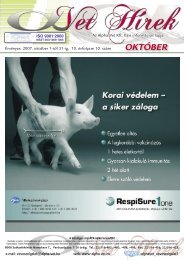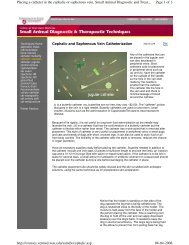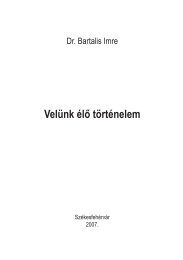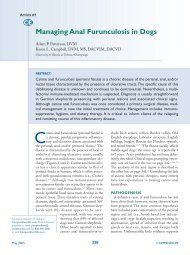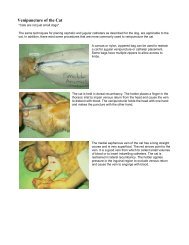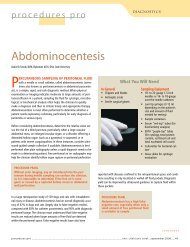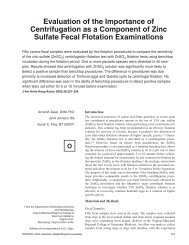Diabetic Ketoacidosis - Hungarovet
Diabetic Ketoacidosis - Hungarovet
Diabetic Ketoacidosis - Hungarovet
You also want an ePaper? Increase the reach of your titles
YUMPU automatically turns print PDFs into web optimized ePapers that Google loves.
18 Veterinary Technician January 2001 <strong>Diabetic</strong> <strong>Ketoacidosis</strong><br />
hypoglycemia (i.e., lethargy, depression, ataxia, weakness,<br />
seizures, coma) recur. Owners should be instructed to<br />
monitor water intake, urine output, body weight, and appetite.<br />
When these factors are normal, diabetic patients are<br />
usually adequately controlled. 5<br />
Initial Plan<br />
Based on history and physical<br />
examination findings, the<br />
veterinarian ordered a complete<br />
blood count to rule out<br />
inflammation and dehydration.<br />
A serum chemistry<br />
panel (including electrolytes)<br />
was conducted to assess metabolic<br />
and electrolyte derangements<br />
(Table II). Urinalysis and culture samples<br />
were taken to rule out glycosuria, ketonuria, and infection.<br />
An ultrasonography was obtained to assess abdominal<br />
pain. A multilumen jugular catheter was placed and a<br />
fluid therapy plan initiated.<br />
Case Report<br />
Lulu, a 6-kg, 8-year-old spayed miniature poodle, presented<br />
with a 2-week history of vomiting that occurred<br />
two to three times per day for<br />
the first week. Although the<br />
poodle did not appear to be lethargic,<br />
it seemed to be getting<br />
progressively worse. The dog<br />
began losing its appetite 1<br />
week earlier and became<br />
anorectic 4 days before admission.<br />
There was a history<br />
of polyuria and polydipsia before<br />
the onset of vomiting.<br />
Lulu was not on any medications,<br />
and the animal’s vaccinations<br />
were current.<br />
On physical examination,<br />
the poodle was depressed but<br />
responsive. Temperature was<br />
103.5°F, with a respiratory<br />
rate of 60 breaths/minute, a<br />
body condition score of 6 out<br />
of 9, decreased skin elasticity<br />
(about 8% dehydrated), and<br />
increased breath sounds in all<br />
lung fields. The midabdomen<br />
was painful; large, firm intestines<br />
were palpated with<br />
hepatomegaly present. The<br />
right prescapular lymph<br />
nodes were enlarged at 1 to<br />
1.5 cm. The dog’s breath had<br />
an acetone smell.<br />
TABLE II<br />
Lulu’s Abnormal Laboratory Values<br />
and Reference Ranges<br />
Reference<br />
Parameters Lulu’s Values Range<br />
Metamyelocytes 750/µl 0<br />
Bands 9750/µl 0–300/µl<br />
Leukocytes 37,500/µl 6000–17,000/µl<br />
Hematocrit 57% 37%–55%<br />
Total protein 9.6 g/dl 6.0–8.0 g/dl<br />
Serum glucose 741 mg/dl 70–120 mg/dl<br />
Potassium 2.1 mmol/L 4.1–5.3 mmol/L<br />
Phosphorus 2.9 mg/dl 3.0–6.2 mg/dl<br />
Total carbon 11 mmol/L 16–26 mmol/L<br />
dioxide<br />
Nursing Actions/Considerations<br />
■ Place a jugular catheter.<br />
■ Initiate a fluid therapy plan.<br />
■ Monitor resolution of dehydration and restoration of<br />
intravascular volume.<br />
■ Monitor resolution of hyperglycemia and ketonuria.<br />
■ Monitor and document fluid “ins and outs.”<br />
■ Consider actions to be taken if pain, fluid overload,<br />
hypoglycemia, evidence of infection, hypo- or<br />
hyperkalemia, or catheter-related problems occur.<br />
Calculation of Lulu’s Fluid Therapy<br />
Replacement volume (6 kg x 0.08) = 0.48 L<br />
Maintenance volume (6 kg x 75 ml/kg/day) = 0.45 L<br />
Total volume<br />
= 0.93 L or 930 ml<br />
930 ml ÷ 24 hours = 39 ml/hour<br />
Note: Abnormal losses (i.e., vomiting, diarrhea, polyuria)<br />
should be made up by adding the previous hour’s abnormal<br />
losses to the next hour’s fluid input.<br />
Nursing Plan/Goals<br />
When placing the jugular catheter, aseptic technique<br />
was used. Steps must be taken to minimize the risk of<br />
bacterial entry when placing<br />
or caring for indwelling<br />
catheters. Likewise, laboratory<br />
samples should be obtained<br />
with minimal stress to<br />
the animal. The goal of the<br />
nursing team in this case was<br />
to develop a fluid therapy<br />
plan using lactated Ringer’s<br />
solution assuming 8% dehydration<br />
(see Calculation of<br />
Lulu’s Fluid Therapy), correct<br />
the dehydration over 24<br />
hours, and replace any abnormal<br />
fluid losses over the next<br />
few hours (see Nursing Actions/Considerations).<br />
Based on laboratory and<br />
imaging results, the poodle’s<br />
problem list included DKA<br />
and pancreatitis. Serum glucose<br />
was 741 mg/dl, and glycosuria<br />
and ketonuria were<br />
present. In addition, Lulu had<br />
hypokalemia, hypophosphatemia,<br />
and metabolic acidosis.<br />
The complete blood count<br />
revealed hemoconcentration<br />
and leukocytosis with a left<br />
shift and marked toxicity. Ultrasonography<br />
of the abdomen<br />
was compatible with<br />
pancreatitis.<br />
Treatment and<br />
Response<br />
Initially, IM regular insulin<br />
therapy was initiated at 1<br />
U/hour and then decreased to<br />
0.5 U/hour. BG was measured<br />
hourly; fluids were supplemented<br />
with dextrose to




